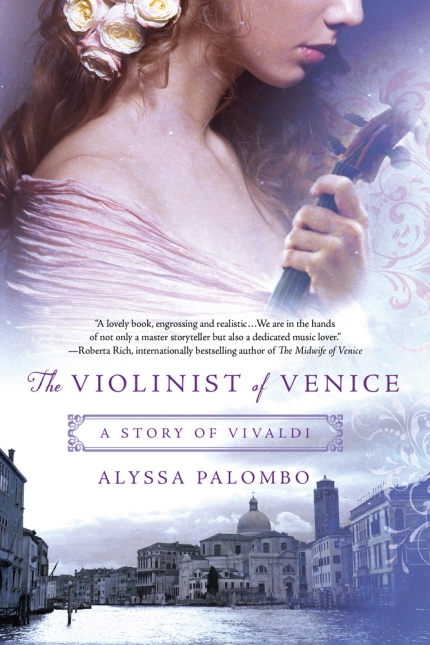The Violinist of Venice: A Story of Vivaldi
- By Alyssa Palombo
- St. Martin's Griffin
- 448 pp.
- Reviewed by Mariko Hewer
- January 8, 2016
Music, passion, and betrayal in 1700s Italy.

Eighteen-year-old Adriana d’Amato’s life is like the city she inhabits — 18th-century Venice, the bold, beautiful Queen of the Adriatic, with its twin reflected in the shimmering canals. The strict, upright part of her existence is composed of days devoid of pleasure as she whiles away the time in her family’s luxurious palazzo under the direction of a strict father. Enrico d’Amato is a calculating man; he keeps Adriana veiled from Venetian society. He deems its morals too lax for his only daughter, whom he hopes eventually to sell in marriage to the highest bidder — much to her dismay.
The mirror image of Adriana’s existence is her secret violin lessons with Venice’s greatest violinist and composer, Antonio Vivaldi. Desperate to resume the violin lessons her father banned, Adriana seeks out il Prete Rosso — the Red Priest — and begs him to take her on as a pupil.
Alyssa Palombo beautifully describes Adriana’s thrill at playing again after years of painful silence and solitude: “Playing the violin again ignited a permanent glow that I carried inside me, which burned gently and steadily just beneath my breastbone…no matter what else I was doing, in my head I was making music. Bursts of color were beginning to flower in the unending gray that had dominated my world for years.”
Adriana and Vivaldi quickly begin an affair brought on by their shared passion for music — so quickly, in fact, that it seems slightly jarring. Although the chapters filled with descriptions of exhilarating music and heady lovemaking are certainly poetic, they are counterbalanced by Vivaldi’s immediate realization, and Adriana’s grudging acknowledgement, that this illicit relationship is shameful and must end eventually.
Palombo uses these scenes to demonstrate the depth and desperation of the lovers’ feelings, and although they carry emotional weight, they eventually become formulaic — a refrain of quarrel, forgiveness, and regret, ad infinitum.
The narrative follows Adriana’s journey into adulthood, focusing less on Vivaldi as Enrico introduces his daughter to society, where she quickly becomes a sought-after object of affection. As Adriana recognizes wryly at her first public appearance, “The air of mystery was part of my allure; it seemed the entire republic knew that I had been essentially locked away in my family’s palazzo until this evening. The d’Amato wealth was equally to thank for such attention.” Still in love with Vivaldi, Adriana steels herself against all attempts to win her heart, but when the handsome and kind Tommaso Foscari begins courting her, she weakens.
While she tries to resist, through a combination of her own conflicting desires and her father’s iron will, she is engaged within a few months. She is also, unbeknownst to all but her maid and manservant, carrying Vivaldi’s child.
Although Adriana pleads with Vivaldi to run away with her and raise their child together, he chooses reinstatement at one of the city’s most famed musical institutions, la Pieta, over her. Adriana is devastated. Shortly after they part, her “condition” is discovered and Adriana’s life begins to spiral downward uncontrollably — her engagement to Tommaso is broken, and she is locked in her rooms until her father decides her fate.
Heartsick, she laments, “I had not thought that anything could be as consuming as the love I had for him, until I knew the anguish of losing him. And was there anything as tragic as the fact that sorrow should be a deeper ocean in which to drown than love?”
It is at this point in Adriana’s story that Palombo’s decision to follow her across more than three decades of her life begins to show strain. It’s difficult to watch the young woman who once dreamed of running away with her first love adjust to her difficult fate. Nevertheless, she finds a heartening joy. “Time passed,” she reflects, “in the peaceful and quietly joyful manner to which I had become accustomed since the births of my children…I spent as much time with them as I could, determined that their childhoods should be as happy and carefree as possible.”
Yet Adriana is never truly free of her memories of Vivaldi, nor of her former fiancé, Tommaso. Palombo’s attempt to recreate the emotional connection between Adriana and Vivaldi in their later years falls somewhat flat, as if each of them is reaching halfheartedly across an abyss they both know cannot be spanned.
One of Adriana’s most powerful insights comes near the end of the book, when she realizes that “love between a man and a woman can take many forms. It need not be a grand, sweeping passion that can carry you to ecstasy and also destroy you. Instead it can be a quieter love, mingled with friendship and respect and desire and a wish to make each other happy.”
It is this thread, perhaps, that runs through the whole of Palombo’s ambitious, sweeping first novel: There are many forms of love, all with their own kinds of suffering and beauty.
Mariko Hewer is a born-and-raised Washingtonian whose hobbies include reading, running, and writing. Her favorite superhero is Daisy Johnson and her favorite food is saag paneer.

